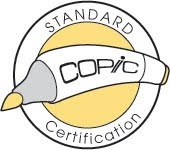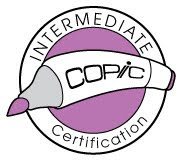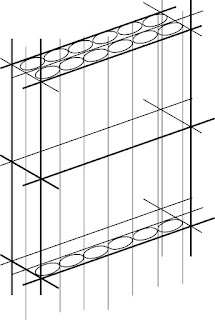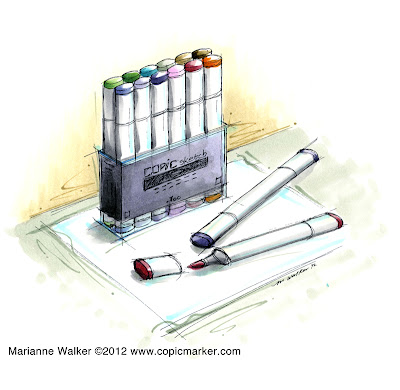Thus far, I have talked about
why you should keep a portfolio, how to be a good viewer, and
things to consider when picking out a good portfolio. Today I want to discuss goals for choosing work to fill your portfolio. I think I will have one more post about portfolios, and then I think you'll be tired of hearing about my portfolios, and maybe you will be ready to start your own.
 Purpose of YOUR portfolio
Purpose of YOUR portfolioThe first portfolio I ever made was in college. I was trying to get into some art classes, and I needed to show a variety of work that I had done. We were having a formal portfolio review, so I really needed to impress the professors to get into the classes I wanted. That portfolio was large. It contained a little graphic design, a little photography, a little illustration, and an assortment of other art I had done. The purpose of that portfolio was to be a showcase of both the best of my work, as well as the breadth of art subjects I could do. This was also a portfolio I could show new freelance clients, to see if they liked my skills and talent. This was (and is) a good portfolio from college.
Since that time, I have had the luxury of narrowing my portfolios. Since I mostly travel for Copic reasons, my current portfolios are all Copic related, and each has a specific purpose. My current goal is to share the variety of subjects that Copics can color.
When you start building a portfolio, you need to define the goal you are trying to achieve with that portfolio. Start by asking yourself a few questions to determine your Portfolio goals:
Which of these are most important to you: • Variety?
• Keeping all my work in one place?• Showing improvement over time?
• Organizing my styles by category?
• Showing only my best?
• Having something that I can share with friends for feedback?Now, as you read some of the following organizational styles, you can choose the ones that fit your goals best. You may find that your organization changes over time, and that is Ok. Every now and then, evaluate your portfolio goals and make sure that your message is coming across.
Sort by kindI usually carry 2 portfolios with me when I travel, 4 for Standard Certification, and 5 if I am teaching an Intermediate Certification. I take everywhere one book for Manga/comics, and one for General Illustrations (not manga). When I am teaching a Certification, I additionally bring one small one with papercrafting techniques, and one for color swatches.

When I teach an Intermediate class, I bring an additional book with all the original art from the Intermediate student manual. Here are the first pages from two of my portfolios, the ship is from my general illustration, the other title page is from my Intermediate book (later I will discuss labeling your work).
At a comic show or at Anime Expo, I show the Manga book first. Then, if people are really interested, I pull out the General Illustration book. When I visit a university or art store, they are interested in the variety of things you can use Copics for, from product design to fashion illustration, so my General Illustration portfolio comes out first. Then if they are interested, I pull out the Manga examples. At Standard Certifications, I refer to my two small portfolios throughout the class, and the two larger portfolios float around. Then I use the Intermediate portfolio for that class.
Different Content CategoriesI could have one portfolio with a little of everything (like my portfolio from college), but then most viewers would only be interested in a small portion at a time, and miss the variety within that one subject. As it is, my General Illustration portfolio has a smattering of everything from architecture, fashion, product design, and freelance illustrations. This only has 48 pages or so, and is just enough to give a flavor of each topic.
Some people sort their work by people in one book, nature/trees in another. Some people sort by card projects in one, individual images in another.
If you don't have much material to put into a bunch of portfolios, it is Ok to have sections inside your book for different topics. Within my manga book, I tend to have characters in the front, fantasy in the middle, and objects in the back (this is not always the case, but I try to stick fairly close to this).
Best to worstI used to think that most people who look at my books start at the front and work their way back. If I am one-on-one with them, then this is frequently the case. However, often my books end up left open to a random page and people start looking where the last person left off. If I organized best to worst, then as soon as the work starts getting bad people stop looking, Then, the next person to come along and thinks all my work isn't very good. Now, I keep mine mixed, good and bad together so one bad piece (that I keep because it shows a technique) doesn't stop people from looking.

If you are showing your book to only a few people, then by all means, put your best stuff first!! I still try to have my favorite images in the front of the book. In the very back of each of my books are images I am not done coloring. I found that some people like to see in-progress stuff, and it motivates me to finish it sooner rather than later. In the back of my Manga book you can find this image that has two versions of a picture that I never finished coloring. Maybe someday I will get around to it.
Newest to oldest (or Oldest to Newest)If the purpose of your book is to show a progress- "look where I used to be, here I am now," then sort by age. Some people have comparison pages...one picture they colored two years ago next to the same picture colored this year. You'll find that your favorite colors change over time, your awareness of shading may have improved, or as your color collection changed, so did the colors you use. I try to keep some older work in my portfolios, but the majority of my stuff is from the last 5 years.
Keep this in mind, if you are looking at my portfolios. If you are a beginner, you are not seeing my beginner stuff, so you can't give yourself a fair comparison between my current work and your level of quality...or, then again, you could see mine and see that your work is just as good or better. Remember, a portfolio is a tool, not a reason to think any less of your own work or someone else's efforts. We are all at different places on our creative ladder, and need to help each other as much as possible.
 Comparison
ComparisonAs an instructor, I have found that people love to see before and after, or step-by-step progressions. Frequently I will have one page with the black & white image, and a colored version next to it. If you don't have too many pieces in your portfolio, then this is also a good way to fill up space.
I almost always carry a spare B & W of each image in the portfolio with the colored copy. This allows people who are curious to see what the line work looks like. Sometimes I carry a few spares, so if I am doing a demo, I can simply pull out a blank image to color. If I end up coloring it good enough, then it replaces the old one. Or, I stick it in front of the old one, so if people ask, I can show them the progression, or different color variations of the same piece.
I hope this has given you some ideas of which art to choose. Now that you have your portfolio, you have a goal, you have your art, my next post will talk about good habits in maintaining a portfolio.
 North American Standard Papercrafting Certification classes
North American Standard Papercrafting Certification classes
















